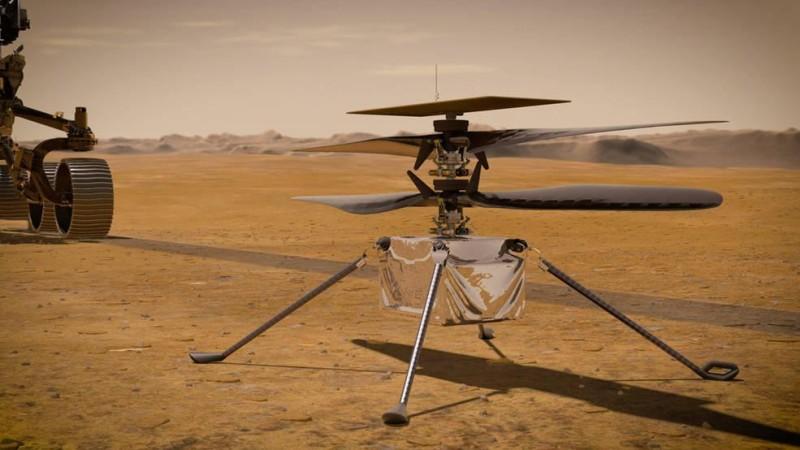In a major boost to NASA's mission to the red planet, the Ingenuity Mars Helicopter—the first aircraft to attempt a controlled and powered atmospheric fight on another planet—successfully survived its first night on the Martian surface on 4th April, 2021.
The 4-pound (1.8 kgs) rotorcraft was 'dropped off' at a chosen site on the Jezero Crater by the Perseverance rover on 3rd April. Following this, the aerial vehicle braved the extreme temperatures, which can fall as low as -90 degrees C, on its own.
"This is the first time that Ingenuity has been on its own on the surface of Mars. But we now have confirmation that we have the right insulation, the right heaters, and enough energy in its battery to survive the cold night, which is a big win for the team. We're excited to continue to prepare Ingenuity for its first flight test," said MiMi Aung, Ingenuity project manager at NASA's Jet Propulsion Laboratory (JPL), in a statement.
Landing on Mars

Perseverance, which was deployed with the search for life on Mars as one of its primary objectives, landed at the Octavia E. Butler Landing site in February 2021. Ingenuity was attached to the belly of the rover till it reached the chosen site for its take-off, and was subsequently released from the probe.
Ingenuity is a technology demonstration—a project that is aimed at testing a new capability for the very first time within a limited scope. Built by JPL, Ingenuity's exclusive mission is to undertake flight tests in Mars' thin atmosphere. After detaching the rotorcraft from itself on 3 April, Perseverance moved away from it in order to ensure that the solar array on top of the craft's rotors may begin receiving sunlight at the earliest.

The first images of Ingenuity on the Martian surface, captured by Perseverance's Hazard Avoidance camera, were downlinked on April 4. In the image, the four footpads of the helicopter can be seen planted firmly in the soil and its rotor blades were still in the same arrangement that enabled its storage inside the rover.
Preparing for Maiden Flight
Over the course of the next few days, information about the performance of the craft's power and thermal-control systems will be monitored. This data will enable the mission team to optimally calibrate the helicopter's systems to function effectively for the entire duration of its flight experiment.
The restraints binding the rotor blades are scheduled to be released on April 7. If this target is accomplished, the mission team will commence testing of the rotor blades and motors over the sols or Martian days (a day on Mars is around 24.6 hours) to come. In addition to the assessment of electronic components and the onboard computers that are responsible for the craft's autonomous flight, its energy performance will also be monitored.

On 6 April, a 'selfie' was captured by the Perseverance. The probe used a camera called WATSON (Wide Angle Topographic Sensor for Operations and eNgineering) that it is equipped with. In the image, the Ingenuity helicopter can be seen at a distance of 13ft (4 meters) from Perseverance.
Ascending into the Martian Skies
When Ingenuity is ready for its first flight, the final set of instructions from JPL mission controllers will be relayed to it by Perseverance. If the preflight checks are glitch-free, the helicopter will attempt its very first take-off from a chosen 'airfield' on the evening of 11 April. The 'airfield' is a 33-by-33-foot (10-by-10-meter) flat and obstruction-free stretch of surface on the Jezero Crater.
Numerous factors will decide the exact time of the flight. One such factor is the modeling of local wind patterns provided by the MEDA (Mars Environmental Dynamics Analyzer) on Perseverance. After ascending at a rate of approximately 3ft per second (1 meter per second) Ingenuity will hover at a height of 10ft (3 meters) for around 30 seconds. Eventually, it will touchdown again on the surface.

After the first flight, Perseverance will transmit data from the helicopter's first ascent to the mission team. Videos and images from Mastcam-Z (a pair of zoomable cameras) and Navigation Cameras will be downlinked along with engineering data. Using the received data, the team will conclude whether the maiden flight was a success or not.
If successful, Ingenuity is expected to complete its testing within 30 sols on the surface of the planet. Subsequently, the probing of the Jezero Crater by the Perseverance will commence at an accelerated pace. "Our 30-sol test schedule is frontloaded with exciting milestones. Whatever the future holds, we will acquire all the flight data we can within that timeframe," said Teddy Tzanetos, deputy operations lead for the Ingenuity Mars Helicopter at JPL.

















